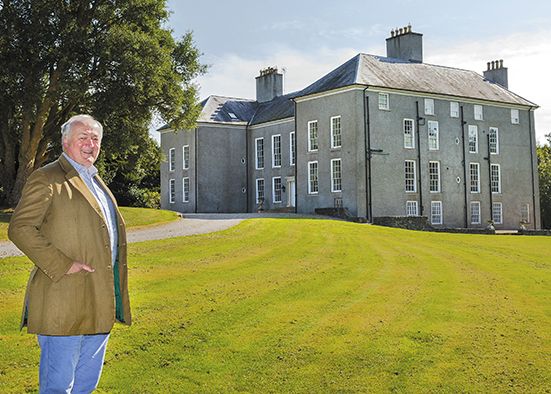House embedded in the history of Downpatrick
House embedded in the history of Downpatrick
25 September 2024

THE owner of a historic country house near Downpatrick has described its renovation as a “labour of love”.
Since 2011, Noel Lamb has been the proud owner of Finnebrogue House, which is located close to the Quoile river.
While the nature of Mr Lamb’s work means he is often away, he says he “absolutely loves” coming home to Finnebrogue and the town of Downpatrick.
Mr Lamb has had an extraordinary life, which began on Antrim’s north coast.
“I was born in Portrush and come from a military family,” he explained.
“My grandfather was injured in the First World War and was sent to the north coast to rest and recuperate.
“Like many others who came to Ulster, my grandparents fell in love with this part of the world and in 1919 built a summer house in Portrush.
“My father and I were both born in that summer house, although my father was raised in Palestine because my grandfather was deployed there during the Second World War.
“My mother Jane, was born in Co Antrim, so I am very much a proud Ulsterman.”
Mr Lamb attended Belfast Royal Academy (BRA) where he developed a passion for history. He went on to study law at Oxford and then had a short service commission in the army with the 5th Royal Inniskilling Dragoon Guards.
It was during the Troubles.
“I had a tour in a police station in Belleek, Co Fermanagh, which is right on the border to the Irish Republic,” Mr Lamb said.
“For a young man in his twenties to be in charge of a troop of soldiers on a border station dealing with a hostile threat it was a rite of passage.
“There were several bomb scares and two riots during my time there. It was a very hostile time and an enormous responsibility – it makes a young man grow up fast.
“Thankfully we had a good rapport with the locals – they were very friendly towards us while others had more of a neutral position.”
Mr Lamb described the peace process as “an amazing accomplishment which has left Northern Ireland in a much better place”.
He is the chairman of Hope For Youth Northern Ireland, a charity which organises and funds art, drama, music and sports projects, providing opportunities for young people from both sides of the sectarian divide to work together and learn new skills.
“It’s a charity that helps the youth become better citizens of tomorrow,” Mr Lamb explained. “It doesn’t eradicate the differences, but it shows everyone that those who you disagree with are worthy of respect.”
To raise funds for the charity, Mr Lamb hosted a musical evening featuring a barbershop quartet on Saturday.
Built in 1660, Finnebrogue is said to be Ireland’s oldest defended house. Sitting in the sun room of his home, Mr Lamb spoke about the rich history of the house and its former occupants, notably the Maxwell family, whose lineage can be traced back to the Scottish Lowlands.
The Maxwells came to Ireland during the reign of Queen Elizabeth I and settled initially in The Pale – a strip of land centred on Dublin that stretched from Dundalk in Louth to Bray in Wicklow.
“Before 1660, there were forts and castles but there were few houses built,” Mr Lamb said.
“You can see throughout the house that there are old musket loops in each wing of the house, which are a throwback to when the home was defended.
“From 1660 to today, with an exception of a Georgian restoration in the 1790s, the house remains largely the same.”
The Maxwell family were Co Down landowners, who, at their peak, owned 8,500 acres.
“I think that Dorothea Waring Maxwell was one of the most remarkable women in the family,” Mr Lamb said.
“When her brother Edward died in 1792, Dorothea inherited Finnebrogue and three years later embarked on an extensive renovation.
“In the early 19th century, the estate employed over 240 people – the home had its own community in many respects.”
It is apparent that Mr Lamb takes great delight in the history of Finnebrogue.
He has found a friend and confidante in Polly Hughes, who has provided extensive information about the house.
In recent years, Mr Lamb met Nora Lennon, who was a maid at Finnebrogue House between 1941 to 1943.
“It was a delight to meet Nora,” Mr Lamb said. “She had wonderful stories about life at the house – it’s where she met her future husband.
“She told me how on the night she arrived the butler did a midnight flit and never came back.
“Some of her duties, such as cleaning the chandeliers, sounded a little dangerous. It was so lovely to listen to her about what life was like in the house during the war and to show her around the house once more.”
After leaving the army in the late 1980s, Mr Lamb was at a crossroads in his life. Describing his knowledge of the law as “rusty”, he decided to go down the financial route and got a job with Lazard, a major financial advisory and asset management firm with offices around the world.
He is now chairman of an investment fund listed on the Stock Exchange and the nature of his job means that he is always travelling throughout the year.
Mr Lamb ended up living in Tokyo for six years which, he said, was “incredible”. In 2011, while living in Seattle in the United States, Mr Lamb received a phone call from friends about a property that recently went on the market.
“They were adamant that I come back and take a look at this house,” Mr Lamb recalled.
“One friend told me I had to buy this house. I came back from Seattle and I drove to Co Down.
“As I was coming up the scenic drive way I was very excited. When I first looked at the house I fell in love with it and knew that I had to have it.
“It was a once-in-a-300-years opportunity to buy something so beautiful and I have never looked back.”
The restoration of Finnebrogue took four years, although he did not make any fundamental changes.
“It was a joy to renovate and it is a home where I love hosting people,” he said.
“It is a house that is embedded in the history of Downpatrick, whose people are friendly, tolerant and have a brilliant sense of community.
“I am honoured to live in a house that has such historical significance to the community.”


